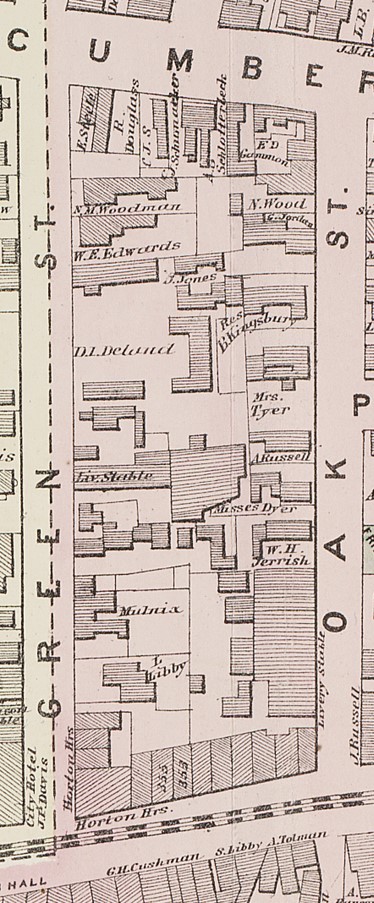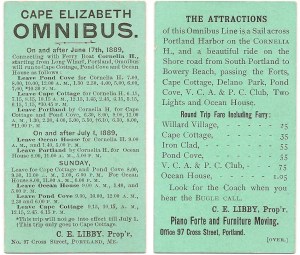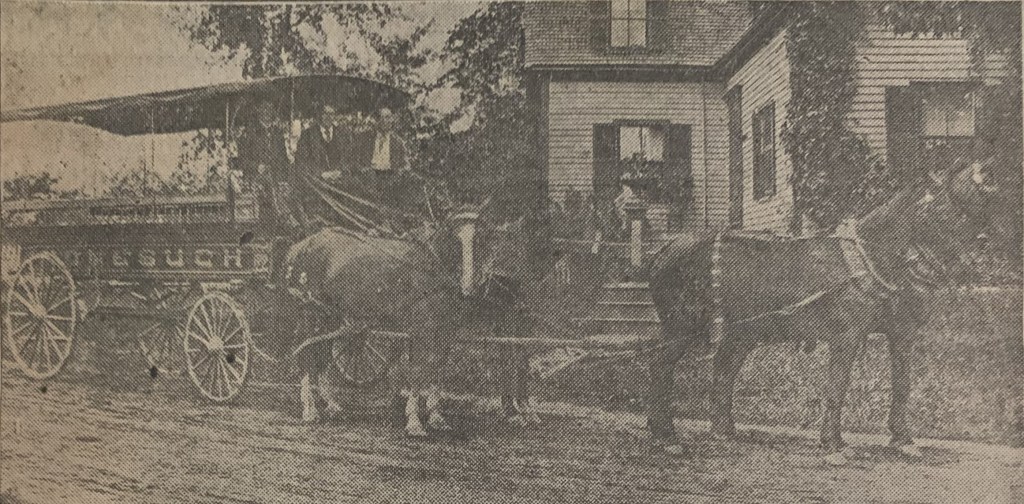

Charles E. Libby’s Nonesuch Barge with its four-horse team, circa 1893, posed in front of the former house at 267 Highland Avenue at the corner of Scamman Street in South Portland. The Nonesuch Barge ran eight times a day on a scheduled route between the Portland post office and the drug store in Knightville. Three shifts of horses were required. In bad weather, curtains were drawn to give passengers some protection. Contribution / South Portland Historical Society
By the early 19th century, public transportation had been developing in cities across America. While stagecoaches covered longer distances overland, within cities the omnibus was a large horse-drawn carriage available to the public for a fixed fare and with regular, scheduled routes. The first omnibus service in America was established in New York City in the 1820s. Compared to larger cities such as Boston and New York, the development of public transportation in Portland and South Portland (known as Cape Elizabeth in the 19th century) was somewhat delayed. Those who did not have their own horse or were not comfortable walking on foot could hire a taxi or “hack” (short for hackney cab or hackney carriage). To offer regular, scheduled routes, a larger population in the Portland area was required.
The first form of mass transportation for residents here on the south side of the Fore River was undoubtedly the Cape Elizabeth Ferry, which ran between Ferry Village and the Portland Peninsula. Steam railroading came here with the formation of the Portland, Saco & Portsmouth Railroad in 1842; the Cape Elizabeth Depot (a passenger station) was built near the intersection of Broadway and Evans Street, where Domino’s Pizza is now located.
The first omnibus we found in Cape Elizabeth was operated in conjunction with the Cape Elizabeth ferry in 1885. The ferry service had just been taken over and established as the People’s Ferry. They proudly announced that they were now offering a combined service with an omnibus, so that passengers could take the ferry at Portland and know that a car was waiting on that side to take them to another destination. Likewise, passengers starting their journey to Portland from Cape Elizabeth could look at the schedule and be assured that they would make it to the ferry, Portland and back at a set time.


In this advertisement, which appeared in the Portland Evening Express on February 27, 1893, Charles Libby announced that he had eight barges (passenger cars) available for rent for special events. Contribution / South Portland Historical Society
We have not yet been able to confirm the operator of the 1885 omnibus at Cape Elizabeth (People’s Ferry has not provided information on who operated it), but it is believed to have been the main operator of the omnibus routes here – Charles E. Libby. We have found documented evidence of Libby’s omnibus at Cape Elizabeth in 1888, when it operated a regular service from the Prospect House in Pond Cove to the Cape Elizabeth ferry.
Charles E. Libby was born in Portland in 1851 and spent much of his life there. One of his first business ventures was a partnership he formed with his brother-in-law, Charles R. Chaffin, in the late 1870s. Under the name Chaffin & Libby, Fruit and Confectionery Dealers, they operated both wholesale and retail stores at 568-570 Congress Street and at 498 Congress Street at the corner of Brown Street. They dissolved their partnership in 1884, but Charles Libby continued the retail store at 498 Congress Street.
Around 1885, Libby began advertising his package delivery business, which was operated with wagons and teams of horses. By 1887, he had hired more people and now housed his growing number of horses and wagons at the livery stable at 27 Green Street (the street was later renamed Forest Avenue; the stable was located approximately where the Portland Stage Company is today). As his business continued to grow, he specialized in the transportation of furniture and pianos.


In this image from the 1871 FW Beers Atlas, the livery stable at 27 Green Street (Forest Avenue) is shown in the center. Charles Libby kept his horses, wagons and carriages at this stable until a devastating fire broke out in 1890, which killed most of his horses. Contribution / South Portland Historical Society
In addition to his delivery business, he developed a significant omnibus business. He hired drivers to drive his “barges” on his regular omnibus routes between Portland and various locations in Cape Elizabeth. This was a year-round operation, on wheels in the summer and on sleigh runners in the winter. The term “barge” was often used at the time to describe a “passenger car” – simply a car into which he had built benches. They were not exactly what you would call a carriage – they were designed and built specifically for passenger transport.
Libby suffered a major setback when a devastating fire broke out in the stables just after midnight on January 1, 1890. A carriage driver who also used the barn spotted the fire and ran to Congress Street to alert the fire station. He ran back and was able to get his two horses and the carriage out and free several other horses, but by then the fire had grown too large. Charles Libby had 29 horses that he normally stabled in this stable – four of the horses were out of town for work, but of his remaining 25 horses on site, over 20 perished in the fire. The fire spread to some sheds and barns on Oak Street, but thanks to the calm winds that night and the quick response of the fire department, the fire was contained.
A report in the Portland Daily Press described Charles Libby’s business at the time: “Mr. Libby is the man who has recently established the extensive omnibus business to Cash’s Corner and other places in the suburbs, and these lines are temporarily suspended. Mr. Libby has employed 17 men, some of whom will now be unemployed.”
Although this was a great loss, Libby quickly rebuilt his business. In addition to offering regular scheduled service to Cash Corner, Knightville, Willard, Pond Cove and East Deering, he also offered private charters so that any person or organization hosting dances or other special events could arrange transportation to and from the event.


This 1889 Cape Elizabeth Omnibus schedule is preserved in the collections of the South Portland Historical Society. Charles Libby offered a combination fare that included both a land ride on his service and a ride on the Cornelia H. Ferry. Contribution / South Portland Historical Society
In some cities, horse-drawn streetcars were one of the next developments in the history of public transportation. The ride in carriages was bumpy, but running a streetcar, even a horse-drawn one, on rails made the ride much smoother and allowed the horses to pull larger loads. However, South Portland had no streetcars until electric trolley service came here in 1895, but the introduction of electric streetcars here marked the end of horse-drawn omnibus services. Electric streetcars provided a smoother ride, fares were cheaper, and operators did not have to worry about feeding and stabling the horses or cleaning up after them. Charles Libby continued to offer transportation for a fee, but on a much smaller scale. The last reference we have found to his service dates back to 1899, when a newspaper article mentioned that the Fort Preble baseball team “will sail to Windham in Libby’s barge today to play against the nine teams of that city.” However, he continued his freight handling business until the early 1920s.
Charles Libby later moved to South Portland, where he lived in the Willard neighborhood, first at 371 Preble Street and then at 19 Day Street. He died in 1925 and is buried in Forest City Cemetery.
The South Portland Historical Society offers a free online museum with nearly 17,000 images that you can view with a keyword search. You can find it at sphistory.pastperfectonline.com. If you appreciate our work, please feel free to make a donation using the donate button on the home page. If you have photos or other information about South Portland’s past that you would like to share with us, we hope you will contact us. You can reach the South Portland Historical Society at 207-767-7299, by email at [email protected], or by mail at 55 Bug Light Park, South Portland, ME 04106.
Kathryn Onos DiPhilippo is executive director of the South Portland Historical Society.
Copy the story link





